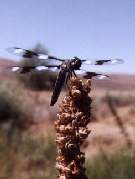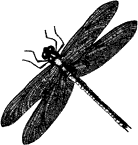Resource Cards

Dragonflies can be found in summer flying around wetland areas or resting on vegetation.
![]()
![]()
What is a dragonfly?
Dating back 300 million years, dragonflies are one of the first winged insects ever found. Fossils of these ancient aquatic insects show wingspans of up to 24 inches compared with the 2- to 5-inch spans of contemporary dragonflies. Scientists have discovered more than 5,000 species of dragonflies worldwide, including 450 in North America alone. Dragonflies belong to the insect order called Odonata, which also includes damselflies. Odonata is a Greek word meaning toothed one. It refers to the serrated teeth located on the insect's chewing mouth parts (mandibles). Myths about dragonflies warned children to keep quiet or else the dragonfly's "darning needles" would sew the child's mouth shut.

What does a dragonfly look like?
Most Columbia Basin dragonflies belong to the family Libellulidae (common skimmer) or Aeschnidae (darners). They have four independent, alternately moving wings that enable them to fly at speeds up to 60 miles per hour, hover, fly backward, stop on a dime, zip 20 feet straight up, and slip sideways in the blink of an eye! This ability, plus a long slender body and large compound eyes, make them true aerial masters of the insect world. Their flight advantage enables dragonflies to generate large amounts of body heat. Thus, they burn 50 times as much energy in flight as the amount they use at rest. A dragonfly's freely movable head has large, hemispherical eyes (nearly 30,000 facets each), which the insects use to locate prey with their excellent vision.
How do dragonflies live?
In the Mid-Columbia Basin, you can see dragonflies in wetland areas, such as along the Yakima River and even at Rattlesnake Springs on the Fitzner/Eberhardt Arid Lands Ecology Reserve. During their 2-week to 2-month life span, adult dragonflies terrorize the skies, snatching and eating midges, mosquitoes, moths, bees, butterflies, or even other dragonflies on the fly. You may see adult dragonflies flying or resting on a plant in tandem as they mate. They aggressively defend their territories from a perch or by patrolling in patterns at various heights.
Dragonflies are highly beneficial predators that destroy large numbers of mosquitoes. Their success as insects results, in part, from the large number of eggs they lay. Depending on the species, dragonflies lay hundreds of eggs by dropping them into the water and leaving them to hatch or by inserting eggs singly into a slit in the stem of a submerged plant. The incomplete metamorphosis (egg, youth nymph, mature nymph, adult) can take 2-3 years. Nymphs are often covered by algal growth. They are voracious predators. After shedding its skin about 12 times, depending on the species, the nymph (naiad), fully grown, crawls out of the water, usually in the early morning to rest on plant stems or rock. Its skin splits along a midline of the thorax, and the adult dragonfly emerges.
![]() "Science is constructed of facts as a house is of stones. But a collection of facts is no more a science than a heap of stones is a house." Henri Poincare
"Science is constructed of facts as a house is of stones. But a collection of facts is no more a science than a heap of stones is a house." Henri Poincare
Keep in mind this fact sheet is intended to be used only as background information to support your effort to encourage inquiry-based science, which parallels the way scientists uncover knowledge and solve problems.

![]()
Observe dragonflies.
Using the OBIS activity "Puddle to Pond," establish an area to attract dragonflies.
Examine dragonflies.
After you've attracted some dragonflies, very carefully capture one. Then, using a jeweler's loupe or magnifying glass, examine its wings. Create a list of metaphors or similes describing the wing.
Write a story about the dragonfly.
Then, using Rudyard Kipling's example, write your own "How the Dragonfly Got its Name."
Questions a scientist might ask: What food in my area would attract dragonflies? How many different species of dragonflies are in the area? How fast does the dragonfly travel? What type of nymph is living in the stream that trout will eat? Because game fish sometimes feed heavily on nymphs, imitations can be valuable in a fisherman's tackle box!
![]()
- Exploring the World of Insects, Adrian Forsyth, 1992. Camden House, Columbia, South Carolina.
- Outdoor Biology Instructional Strategies (OBIS), Lawrence Hall of Science, University of California, Berkeley, California.
- The Audubon Society Field Guide to North American Insects & Spiders, 1984. Alfred A. Knopf, New York.
- Eyewitness Books-Insect, Laurence Mound, 1990. Alfred A. Knopf, New York, (Incomplete metamorphosis p. 26-29).
- Shrub-Steppe Seasons: A Natural History of the Mid-Columbia Basin, Lee E. Rogers, 1995. Pacific Northwest Laboratory, Richland, Washington.
![]()
- Dragonfly Site - http://www.dragonfly-site.com/index.html
- Dragonflies and Damselflies (Odonata Information Network) - http://www.iodonata.net/
- Slater Museum of Natural History - Dragonfly Diversity - http://www.ups.edu/x5666.xml
- USGS Dragonflies and Damselflies of the United States - http://www.npwrc.usgs.gov/resource/distr/insects/dfly/dflyusa.htm
![]()
Initial development and printing of this fact sheet was funded by an Eisenhower Grant to the Partnership for Arid Lands Stewardship. Written by Marilyn Fike; Series Editor: Georganne O'Connor; Design: WinSome Design; Printing: Eagle Printing and Graphic Design; First Printing: December 1997; Web Development: WinSome Design.
![]()
